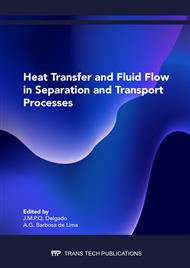[1]
https://www.wbdg.org/resources/sun-control-and-shading-devices. [Accessed in 25/12/2021].
Google Scholar
[2]
G. Kumar e G. Raheja, Design Determinants of Building Envelope for Sustainable Built Environment: A Review, International Journal of Built Environment and Sustainability, pp.111-118, (2016).
DOI: 10.11113/ijbes.v3.n2.127
Google Scholar
[3]
https://poupaenergia.pt/en/dicas/thermal-insulation/. [Accessed in 25/12/2021].
Google Scholar
[4]
P.M.E. Nunes, Thermal performance of different envelope, Técnico de Lisboa, (2014).
Google Scholar
[5]
X. Li, C. Shen e C. Yu, Building energy efficiency: Passive technology or active technology, Indoor and Built Environment, pp.729-732, (2017).
DOI: 10.1177/1420326x17719157
Google Scholar
[6]
Yannas, S. and E. Maldonado, Handbook on Passive Cooling - Comfort, London and Porto, European Commission PASCOOL, (1995).
Google Scholar
[7]
S. V. G. Goulart, Thermal Inertia and Natural Ventilation, Architectural Association School of Architecture, (2004).
Google Scholar
[8]
https://nulinewindows.com.au/blog/passive-building-design-and-energy-efficiency. [Accessed in 23/02/2021].
Google Scholar
[9]
https://ncma.org/resource/thermal-bridges-in-wall-construction/. [Accessed in 23/11/2021].
Google Scholar
[10]
M. Cunningham, Condensation and Thermal Bridge, Build Magazine, pp.22-23, (2005).
Google Scholar
[11]
https://www.schoeck.com/en-gb/structural-thermal-bridges. [Accessed in 23/11/2021].
Google Scholar
[12]
T. Kisilewicz, On the Role of External Walls in the Reduction of Energy Demand and the Mitigation of Human Thermal Discomfort, Sustainability, (2019).
DOI: 10.3390/su11041061
Google Scholar
[13]
Isolamento de Paredes, ADENE - AGÊNCIA PARA A ENERGIA, (2016).
Google Scholar
[14]
L. S. Paraschiv, P. Spiru e I. V. Ion, Increasing the energy efficiency of buildings by thermal insulation, International Scientific Conference "Environmental and Climate Technologies, Riga, Latvia, (2017).
Google Scholar
[15]
V. P. Freitas, isolamento térmico de fachadas pelo exterior reboco delgado armado sobre poliestireno expandido –ETICS, Porto, (2002).
Google Scholar
[16]
https://www.ulmaarchitectural.com/en/facade-cladding/news/what-is-a-facade-cladding-system. [Accessed in 24/02/2021].
Google Scholar
[17]
https://conceptsurfaces.com/other-products/ventilated-facade-systems, [Accessed in 24/11/2021].
Google Scholar
[18]
D.M.B.F.G. Corrêa, Reabilitação térmica de fachadas de edifícios, Dissertação de Mestrado, Técnico de Lisboa, (2016).
Google Scholar
[19]
A.D.O. Primo, Estudo da Durabilidade de Elementos Construtivos, Dissertação de Mestrado, FEUP, (2008).
Google Scholar
[20]
Isolamento de Coberturas, ADENE - AGÊNCIA PARA A ENERGIA, (2016).
Google Scholar
[21]
https://www.burtonroofing.co.uk/blog/warm-roof-vs-cold-roof-whats-the-difference/ [Accessed in 27/11/2021].
Google Scholar
[22]
https://great-home.co.uk/a-guide-to-roof-construction/cold-roof-and-warm-roof-difference-2/. [Accessed in 27/11/2021].
Google Scholar
[23]
https://www.energy.gov/energysaver/design/energy-efficient-home-design/cool-roofs. [Accessed in 27/11/2021].
Google Scholar
[24]
BuildUp, Cool roofs in Europe: initiatives and examples.
Google Scholar
[25]
https://www.energy.gov/energysaver/design/energy-efficient-home-design/cool-roofs. [Accessed in 27/11/2021].
Google Scholar
[26]
https://www.epa.gov/heatislands/using-green-roofs-reduce-heat-islands. [Accessed in 27/11/2021].
Google Scholar
[27]
A. Teemusk, Ü. Mander, Greenroof potential to reduce temperature fluctuations of a roof membrane: A case study from Estonia, Building and Environment, pp.643-650, (2009).
DOI: 10.1016/j.buildenv.2008.05.011
Google Scholar
[28]
Janelas Eficientes,, ADENE - AGÊNCIA PARA A ENERGIA, (2016).
Google Scholar
[29]
https://www.energy.gov/energysaver/window-types-and-technologies. [Accessed in 27/11/2021].
Google Scholar
[30]
M. Casini, Smart windows for energy efficiency of buildings, Second Intl. Conf. on Advances In Civil, Structural and Environmental Engineering, (2015).
Google Scholar
[31]
[https://www.designingbuildings.co.uk/wiki/Triple_glazing. [Accessed in 27/11/2021].
Google Scholar
[32]
https://replacementwindowsofkaty.com/double-pane-or-triple-pane-glass-houston/. [Accessed in 27/11/2021].
Google Scholar
[33]
Yujie Ke, Yin Yin, Qiuting Zhang, ..., Qihua Xiong, Dongyuan Zhao, Yi Long, Adaptive Thermochromic Windows from Active Plasmonic Elastomers, Joule: Cell Press, 20/03/2019, p.858.
DOI: 10.1016/j.joule.2018.12.024
Google Scholar
[34]
Proteções Solares,ADENE - AGÊNCIA PARA A ENERGIA, (2016).
Google Scholar
[35]
https://www.wbdg.org/resources/sun-control-and-shading-devices. [Accessed in 28/11/2021].
Google Scholar
[36]
Introduction to Building Climatology - Chapter 4 - Shading Devices OCR.
Google Scholar
[37]
https://www.tboake.com/carbon-aia/strategies1b.html. [Accessed in 31/10/2021].
Google Scholar
[38]
https://www.energy.gov/energysaver/natural-ventilation. [Accessed in 07/11/2021].
Google Scholar
[39]
R. Gonzalez-Lezcano e S. Hormigos-Jimenez, Energy saving due to natural ventilation in housing blocks in Madrid, em IOP Conference Series Materials Science and Engineering, (2016).
DOI: 10.1088/1757-899x/138/1/012002
Google Scholar
[40]
Rakesh Khanal, Chengwang Lei, Solar chimney—A passive strategy for natural ventilation, Energy and Buildings,2011, pp.1811-1819.
DOI: 10.1016/j.enbuild.2011.03.035
Google Scholar
[41]
R. Khanal e C. Le,Energy and Buildings, pp.1811-1819, (2011).
Google Scholar
[42]
D.J. Harris e N.Helwig, Solar chimney and building ventilation, Applied Energy, vol. 84, nº 2, pp.135-146, (2007).
DOI: 10.1016/j.apenergy.2006.07.001
Google Scholar
[43]
https://www.commercialwindows.org/ventilation.php. [Accessed in 07/11/2021].
Google Scholar
[44]
https://www.designingbuildings.co.uk/wiki/Airtightness_of_energy_efficient_buildings. [Accessed in 07/11/2021].
Google Scholar
[45]
S. J. Hayter e A. Kandt, Renewable Energy Applications, International Conference Baveno-Lago Maggiore, Italy, (2011).
Google Scholar
[46]
https://www.energy.gov/eere/solar/solar-photovoltaic-technology-basics. [Accessed in 19/11/2021].
Google Scholar
[47]
https://www.energy.gov/eere/solar/solar-photovoltaic-technology-basics. [Accessed in 19/11/2021].
Google Scholar
[48]
https://www.seia.org/initiatives/photovoltaics. [Accessed in 19/11/2021].
Google Scholar
[49]
https://www.indiamart.com/proddetail/on-grid-connected-pv-system-18671435597.html. [Accessed in 19/11/2021].
Google Scholar
[50]
N. ManojKumar, K.Sudhakar e M.Samykano, Performance comparison of BAPV and BIPV systems with c-Si, CIS and CdTe photovoltaic technologies under tropical weather conditions, Case Studies in Thermal Engineering, (2018).
DOI: 10.1016/j.csite.2018.100374
Google Scholar
[51]
https://new-q-cells.com/en/sub.php?idx=818&division=2&page=0. [Accessed in 31/05/2021].
Google Scholar
[52]
https://www.energysage.com/solar/101/monocrystalline-vs-polycrystalline-solar-panels/. [Accessed in 19/11/2021].
Google Scholar
[53]
https://www.tindosolar.com.au/learn-more/poly-vs-mono-crystalline/. [Accessed in 19/11/2021].
Google Scholar
[54]
M.A.C. Sousa, Dimensionamento e Parametrização Automática de Sistemas de Energia Fotovoltaica em Edifíficos, Dissertação de Mestrado, Faculdade de Ciências e Tecnologias da Universidade de Coimbra, (2018).
DOI: 10.32385/rpmgf.v29i2.11056
Google Scholar
[55]
J. Eyer and G.Corey. Energy Storage for the Electricity Grid : Benefits and Market Potential Assessment Guide. Sandia Report, (February):232, (2010).
DOI: 10.2172/1031895
Google Scholar
[56]
A. Kylili and P.A. Fokaides. European smart cities: The role of zero energy buildings. Sustainable Cities and Society, 15(2015):86–95, (2015).
DOI: 10.1016/j.scs.2014.12.003
Google Scholar
[57]
P.T. Pacheco. Development and optimization of a passive internal mixing strategy for the electrolyte tanks in a commercial redox flow battery system. Master's thesis, Faculdade de engenharia da Universidade do Porto, (2018).
Google Scholar
[58]
S. Weber, J.F. Peters, M. Baumann, and M. Weil. Life Cycle Assessment of a Vanadium Redox Flow Battery. Environmental Science and Technology, 52(18):10864–10873, (2018).
DOI: 10.1021/acs.est.8b02073
Google Scholar
[59]
G.P.L. Teixeira, Energy Autonomous Buildings, Dissertation in Building Construction, University of Porto, Portugal, (2021).
Google Scholar
[60]
www.vinylbilt.com, [Accessed in 11/12/2021].
Google Scholar
[61]
D.F.C.S. Monteiro, Dimensionamento de um Sistema de Armazenamento de Energia, MSc. Thesis, Universidade de Coimbra, (2017).
Google Scholar
[62]
https://www.linkedin.com/pulse/role-cfd-evaluating-occupant-thermal-comfort-sandip-jadhav/. [Accessed in 19/11/2021].
Google Scholar
[63]
https://www.simscale.com/blog/2019/08/what-is-ashrae-55-thermal-comfort/. [Accessed in 19/11/2021].
Google Scholar


